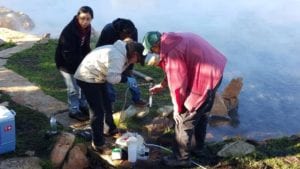Most people visit the Western Cape’s hot water springs for health and relaxation, but a recent trip had a more serious scientific purpose: to grow international understanding of complex microbial systems.
Representatives of local and overseas universities visited hot springs and thermal artesian boreholes in areas such as Montagu, Citrusdal and Calitzdorp from June 26 to July 1 this year. They were on a metagenomics sampling tour, to study genetic material recovered directly from environmental samples. “Metagenomics is the genomic (full set of chromosomes) analysis of micro-organisms by direct extraction and cloning of DNA from an assemblage of microbes,” said Umvoto Africa technical director Dr Chris Hartnady, one of the participants. “What strange and novel life-forms may inhabit deep groundwater systems and flow paths in the Table Mountain Group, we still hope to discover.” The overall project goal is to characterise the microbial, geochemical and isotopic properties of thermal spring sources and artesian wells in South Africa, said Dr Hartnady. “These will be compared with the extensive South African sub-surface data set derived from the deep mines, to construct a regional picture of the deep continental biosphere.”








